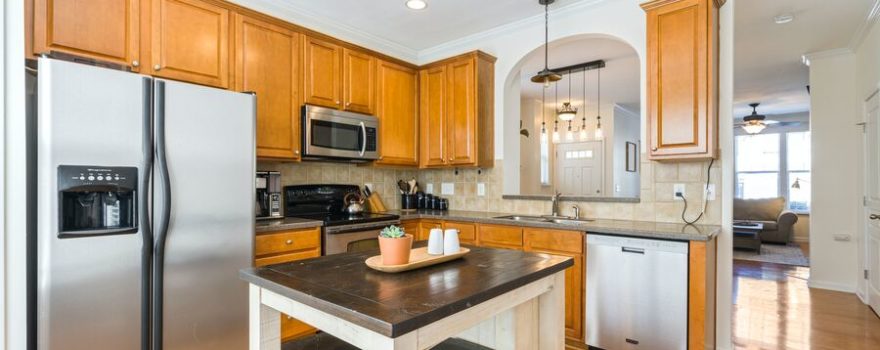
A fridge is an essential part of the kitchen. And advances in fridge technology have increased efficiency. And are designed to make your life easier. As well as keeping food fresh for longer, they also cut down on wasted energy. So, how many watts does a fridge use? Read on…
Actual Energy Consumption
Fridge energy consumption depends on many things including:
- Age – new high starred rated appliances are more efficient than older fridges
- Condition – your fridge will be less effective if components such as seals are worn
- Location – more power is used if your fridge is poorly ventilated or in a warm area
- Seasons – as the ambient temperature is higher in the summer fridges use more power then
- Size – larger volume fridges use more electricity
- Temperature setting – the factory setting may be higher than needed when the fridge is in your kitchen
- Type – a commercial fridge can use 10 times more electricity than a domestic appliance
- Usage – the compressor in an empty fridge or when the door is frequently opened has to work harder
Refrigerator Wattage Calculation
How many watts does a fridge use?
The individual wattage for your fridge is worked out with the figures provided by the manufacturer. You’ll find a sticker informing you of the voltage and amperage of the appliance. For example, 120 volts and 6 amps multiplied together will get a current of 720 watts.
Modern fridges are very energy efficient compared to older models. You can get a small fridge that uses a mere 100 watts, and even larger styles will use from 180 to 400 watts annually.
Refrigerator energy consumption can be determined by finding the daily or annual rating to use as your base calculation. Multiply the unit’s wattage by the number of hours you use it to find watt-hours consumed. On your electricity bill the measure is in kilowatt hours. So, you’ll need to divide that figure by 1000.
Then you have to work out how much kWh is used by your fridge each month by multiplying it out. You’ll then be able to calculate the cost of operating your fridge by seeing how much you pay per kilowatt hour. There are plenty of online conversion charts to avoid any over-complicated mathematics!
A fridge power consumption calculator can be used to find out the actual wattage of your refrigerator as these devices measure rather than estimate a 24-hour period to see how much kWh the appliance uses.
Fridge star ratings are an excellent guide to fridge electricity consumption but due to variable factors, the most accurate way to learn how much power your fridge is using is to use a plug-in power meter.
Fridge Wattage Comparisons
Refrigerator power consumption in watts varies from small fridges which use between 90 and 100 watts when the compressor is running. A power meter reading shows this size of fridge has an average fridge power consumption of 0.6 kWh within 24 hours – drawing power for just over six hours during this time.
Commercial refrigeration is more intricate and complex to measure actual fridge freezer energy consumption – yet energy savings can be much greater. Research has shown that over half of the electricity costs in some businesses are due to poor refrigeration maintenance.
The sheer volume of refrigerators may be the problem but consolidating the number of devices in use, maximising insulation and minimising air changes are basic changes that can increase the energy efficiency of appliances.
If you want to know more about your individual refrigerator electricity usage check the manufacturing date. You’ll be able to use an online fridge calculator to estimate how much you may be able to save by replacing your existing model with a modern energy star rated one.
Consumption Comparisons
The power consumption of household appliances compared to your fridge are much greater. Your tumble dryer for example will use almost six times more even though you use it for less time. And this figure can be up to 5,000 watts. Dishwashers use approximately 1,800 watts, with laptops and other small electrical appliances coming in at around 50 watts or less.
Energy-starred refrigerators use much less electricity. About 20% less than older models. Appliances are graded from A to G. A is the most efficient based on how many units of energy used per hour – the kWh consumption. The lower the consumption the more efficient the appliance is.
Generally speaking the greater the internal volume of the fridge, the more it will cost to run.
Reducing Fridge Power Consumption
Refrigerator power consumption can be cut by following a few simple guidelines:
- Combine the number of fridges in use – if you have an extra fridge in the garage which is only ever partially full, empty it and switch it off
- Make sure fridges are well ventilated – fridge power consumption can rise substantially if the fridge is jammed in without any airing room
- Regularly check and adjust the temperature settings in the fridge and freezer – fridge freezer power consumption can be affected by setting that’s too cold. Use a thermometer to safely change the settings
- Use timer switches where appropriate – these will ensure that drinks and bar fridges are only in when needed
Benefits of Upgrading
As your fridge is on 24 hour a day it makes sense to have one that also fits in more food more efficiently. Thinner insulation panels free up much more space for storage.
Modern designs ensure there are plenty of useful storage spaces. Sliding shelves, butter keepers, and extra deep door pockets all contribute to using less energy as cold air has more room to circulate. The best size is between 16 and 20 cubic feet to avoid overfilling.
Your fridge consumes less than 15% of your home’s energy. And the type of model you choose can affect that figure. Opening the fridge door accounts for about 7% of that total energy usage. Side-by-side fridges incorporate exterior drawer concepts let you access regularly used items without opening the main fresh food compartment. This reduces the amount of energy used even further.
Setting up parts of your fridge to become a freezer is brand new technology. In warmer months with more fresh food and perishable items you can set three fridge and one freezer compartment. As the weather changes you can turn both bottom compartments into freezers.
Energy Saving Tips
Freezer power consumption is also affected by the factors shown below:
Cleanliness
Try and pull the refrigerator away from the wall about every three months to dust the coils located at the back. Use a long narrow brush to clean underneath – when your appliance is clean it uses less energy
Storage
If you’re refrigerating leftovers make sure they’re completely cool before putting them into the fridge. When the compressor has to work harder to cool food down it uses more energy
Sealing
The rubber gaskets around the fridge and freezer doors keep the cold air inside. Any leaks from loose-fitting or worn seals will cause the fridge to work less effectively and should be replaced
Need a Fridge Repair?
When your fridge isn’t working properly your local appliance repair experts will have a solution. A team of fully qualified engineers will quickly diagnose the problem. And fix it on the spot. You’ll get a fast response time. Be able to make an appointment that suits you. And get a six-month parts and labour guarantee. It’s as easy as that.



